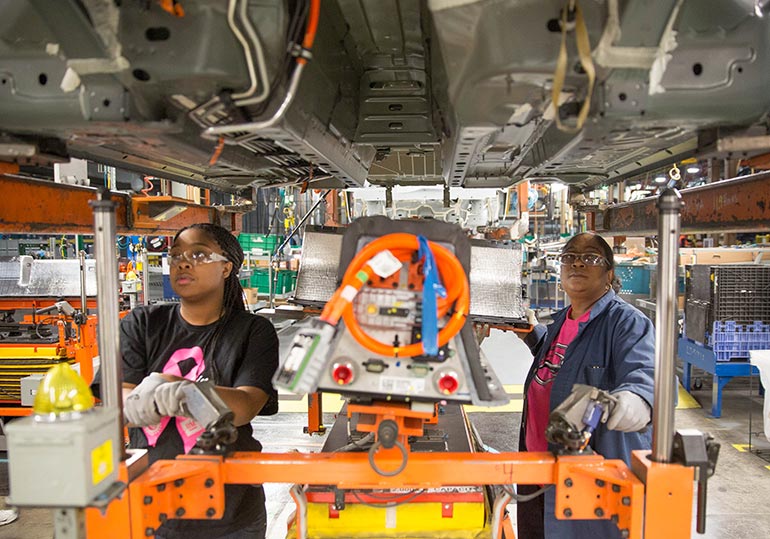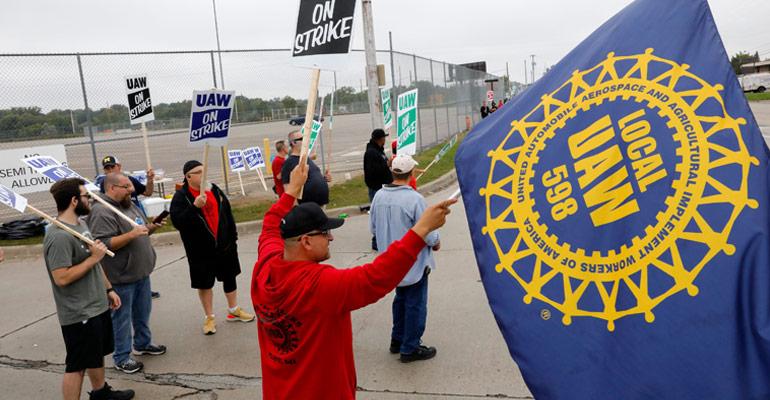The United Auto Workers union has sent for ratification a tentative contract to 48,000 striking members employed by General Motors, but the union’s pickets will remain in place, halting GM’s production for at least another week.
Brian Rothenberg, UAW director-communications, says voting will be complete by Friday Oct. 25. If the contract is approved the pickets will come down then, ending the strike, which began Sept. 16 and is now the UAW’s longest national strike against GM since 1970.
The union also has reached a tentative agreement with Aramark, which employs 850 maintenance workers at six GM plants in Michigan and Ohio. They went on strike Sept. 15.
For GM, the proposed agreement is expensive and introduces new restrictions on the use of temporary workers but also clears the way for GM to close or sell plants in Baltimore, MD; Warren, MI; and most importantly in Lordstown, OH.
The strike has cost GM more than $2 billion in earnings before interest and taxes, according to John Murphy, an analyst with Bank of America/Merrill Lynch.
In return, GM has pledged to invest $7.7 billion in upgrading plants and new products. The union didn’t spell out the investments, but as much as $2 billion is earmarked for highly automated production of electric trucks and SUVs at GM’s Detroit-Hamtramck plant (see photo below), which the automaker “unallocated” last November. Keeping the plant open will save or protect as many as 9,000 jobs.
“Some of these investments are not under the master agreement,” Rothenberg says.
He adds Lordstown’s ultimate fate is open to further discussion around the commitment of an additional $1.3 billion to develop a battery plant and the sale of the plant to a new owner.
GM still expects to sell the vacant plant in northeast Ohio to Work Horse, a start-up company planning to build electric work trucks or postal vehicles there. GM also is hoping to recruit a partner for a joint venture to build batteries in a new factory in northeast Ohio.
“The fact that it is greater than the initial $7.7 billion is helpful for the union leadership to show that they got an improved figure,” notes Alan Baum of Baum and Associates. “Of course, these numbers are always subject to market conditions, and the jobs numbers are often ‘new or retained’ and of course most are retained.”
Baum says the Detroit Three “continue to lose share in crossovers and are increasingly small players in sedans,” making pricing and profits associated with SUVs and pickups critical.
 However, workers from Ohio attended the Detroit meeting of the GM Council and expressed frustration with the proposed agreement.
However, workers from Ohio attended the Detroit meeting of the GM Council and expressed frustration with the proposed agreement.
“GM doesn't care about workers,” says John Debanardo, a 25-year GM veteran from Lordstown who was disappointed the UAW could not stop the plant shutdown. “Work Horse can’t even afford to pay the plant’s light bill. If GM wanted to, they could have bought Work Horse’s Technology and used it.”
Debanardo says Lordstown had 4,500 workers before GM started cutting. “First the third shift and then the second and then they closed the plant,” he says. “GM doesn't want to be in the car business.”
The UAW, however, did score major gains for workers hired by GM since the end of the recession in 2009 and for temporary workers, who have taken center stage in the dispute.
The contract includes an $11,000 signing bonus and a $4,500 signing bonus for temporary workers.
In addition, workers who have been permanent temporary workers for three years will become full-fledged GM employees on Jan. 6, 2020. “It could be life-changing for many of them,” says Rothenberg, adding it could eventually end the use of “perma temps” across the U.S. economy.
The union won greater say over the employment of temporary workers in various plants, according to the settlement summary, but Rothenberg could not say if the percentage of temporary workers used by GM would decline.
About 7% of GM hourly workers are temps, according to the company, which says temporary employees are critical to holding down labor costs. GM’s labor costs are the highest in the industry, according to the Ann Arbor-based Center for Automotive Research.
The tentative agreement also includes a shorter path to top wages. New hires will remain “in progression for four rather than eight years to reach the top wage of $32.32” at the end of the four-year agreement.
The contract includes a 3% raise in the second and fourth year and a 4% lump sum or performance bonus in the first and third contract year. The first lump sum payment will go out in November if the contract is ratified, according to the UAW’s contract summary.
The union summary also says there were no changes in health-care coverage, which remains comprehensive but now will cost GM's blue-collar employees a modest 3% in co-pays and deductibles. Profit-sharing, which is capped at $12,000 in the current contract, was uncapped in the tentative agreement.
The UAW’s scandal-ridden Center for Human Resources will be revamped and its under-utilized CHR headquarters building on the Detroit River will be sold and the money put back into joint training programs, which will continue.
GM, meanwhile, is urging union members to approve the tentative agreement.
“We encourage the UAW to move as quickly as possible through the ratification process, so we can resume operations and get back to producing vehicles for our customers,” GM says in a statement.
“The agreement reflects our commitment to U.S. manufacturing through the creation of new jobs and increased investment,” the automaker says.





